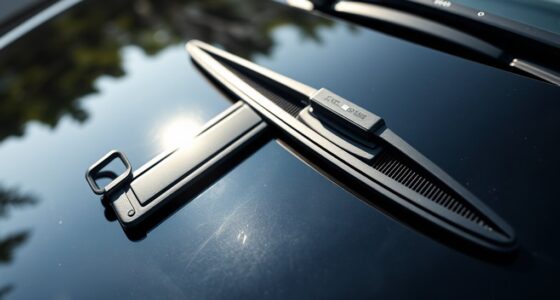Headlights come in three main types: halogen, LED, and HID. Halogen headlights are common and affordable, using a filament to produce light. LED headlights are more efficient, brighter, and can create precise beam patterns. HID headlights produce intense, long-reaching beams ideal for visibility but require proper installation to avoid glare. Understanding these differences can help you choose the right headlights for safety and legal compliance; you’ll find more details if you keep exploring.
Key Takeaways
- Halogen headlights are affordable and produce a warm, wider beam, but are less focused and may cause glare.
- LED headlights offer brighter, crisper light with precise beam control, reducing glare and enabling innovative designs.
- HID headlights emit intense, long-range light through xenon gas arcs, ideal for high visibility but require proper regulation and alignment.
- Each headlight type has different mechanisms, efficiencies, and beam patterns, affecting safety, visibility, and compliance.
- Understanding these differences helps select headlights that are effective, safe, and legally compliant for night driving.

Headlights Explained
Have you ever wondered how headlights work or why they come in different types? It all comes down to how each technology produces light and how that light is directed. Different headlight types—halogen, LED, and HID—offer unique beam patterns that influence how well they illuminate the road and how they comply with lighting regulations. These regulations are vital because they ensure your headlights are effective without blinding other drivers. When choosing headlights, understanding these distinctions can help you pick the right type for safety and legality.
Starting with halogen headlights, they’re the most common and affordable option. They produce light by passing electricity through a tungsten filament, which heats up and emits visible light. The beam patterns of halogen bulbs tend to be less precise, often resulting in a wider, less focused spread of light. This can sometimes cause glare for oncoming drivers, especially if the headlights aren’t properly aligned. Despite their simplicity, halogen headlights must still meet specific lighting regulations that dictate brightness and beam cutoff to prevent dazzling others on the road. These regulations are essential because they guarantee that the light emitted is sufficient for visibility without compromising safety. Understanding beam patterns is crucial for ensuring proper headlight function.
Halogen headlights are affordable but produce wider, less focused light that must meet safety regulations.
LED headlights, on the other hand, utilize light-emitting diodes that produce light more efficiently. They generate brighter, crisper beams and often have more sophisticated optics that allow for highly controlled beam patterns. This means they can be designed to focus light precisely where it’s needed, reducing glare and improving visibility. Because of their ability to produce sharp cutoff lines and consistent illumination, LEDs often meet or exceed lighting regulations more easily than halogen bulbs. Their compact size also allows for innovative headlight designs, which can further enhance beam patterns and overall road safety.
HID headlights, or High-Intensity Discharge lights, work by passing an electric arc through xenon gas, producing a very bright and intense light. They tend to have a longer reach and a more focused beam pattern than halogen bulbs, providing excellent visibility over long distances. However, their beam patterns can sometimes be less uniform if not properly installed, potentially causing glare. That’s why strict adherence to lighting regulations is essential for HIDs. When correctly installed and adjusted, they offer a powerful lighting solution that improves night driving without compromising safety.
Frequently Asked Questions
How Do Headlight Types Affect Vehicle Resale Value?
You might notice that headlight types influence your vehicle’s resale value factors. Upgrading to modern headlights like LEDs or HIDs can boost your car’s appeal, making it more attractive to buyers. These headlight upgrades show you’re maintaining or improving your vehicle, which can positively impact resale value. Conversely, sticking with outdated halogen lights may make your car seem less desirable. So, choosing the right headlight type can be a smart resale strategy.
Are There Any Legal Restrictions on Aftermarket Headlight Upgrades?
You should know that legal restrictions on aftermarket upgrades vary by location, so check local laws before installing new headlights. Many regions have regulations about brightness, color, and beam pattern to ensure safety and avoid fines. Always verify that your aftermarket upgrades meet legal standards, as non-compliant headlights can lead to penalties or vehicle inspection issues. Staying informed helps you enjoy improved visibility without risking legal trouble.
Do Different Headlights Impact Nighttime Driving Safety?
When it comes to nighttime driving, your headlights can make all the difference. Different types, like halogen, LED, or HID, affect safety by influencing beam pattern and glare reduction. Bright headlights might seem like a blessing, but they can also blind other drivers if not properly designed. Choosing the right headlights improves visibility and keeps everyone on the road safe—it’s a case of lighting the way without casting shadows.
How Do Headlight Bulbs Perform in Extreme Weather Conditions?
In extreme weather, your headlight bulbs play a vital role in fog performance and snow visibility. Halogen bulbs may struggle with fog, scattering light and reducing clarity, while LEDs offer clearer illumination and better visibility in snowy conditions. HID bulbs typically provide intense brightness, but their performance can diminish in fog or snow. For safer driving, choose headlights designed for adverse weather, ensuring you see clearly and stay safe.
What Maintenance Is Required for Each Headlight Type?
You need to regularly maintain your headlights by replacing bulbs when they burn out or become dim. For all types, lens cleaning helps guarantee maximum brightness and clarity. Halogen bulbs often require more frequent bulb replacements, while LEDs last longer but still need occasional inspection. HID headlights may need special handling during bulb replacement. Keep lenses clean and replace bulbs promptly to maintain safe, effective lighting on the road.
Conclusion
Now that you’ve seen the bright differences between halogen, LED, and HID headlights, you’re like a navigator with a clear map in the dark. Each type shines with its own personality, illuminating your path ahead. Choosing the right headlights is like picking the perfect torch for your journey—bright, reliable, and tailored to your needs. So, gear up and let your headlights be the guiding stars in your nightly adventures, lighting the way with confidence.









